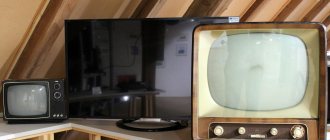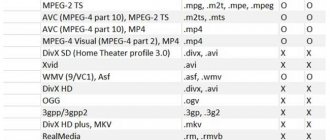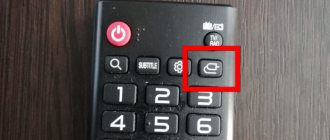Despite all the apparent diversity in entertainment electronics, there are very few truly unique devices, and those whose uniqueness is clear to everyone are very few. This TV is one of them.
Having not the largest screen diagonal, it impresses everyone without exception. Not long ago, displays that could be rolled into a roll were considered the stuff of science fiction, but now you can simply buy one. Although, to be honest, it’s not entirely simple. It costs 7,200,000 rubles - the same as a small apartment in Moscow. And to purchase, you first need to leave a request on the official website. All this in our age of mass production looks very strange and unusual, but in fact it is understandable.
It is made only in Korea and is not assembled in local factories around the world like other TVs. And the price... The fact is that the LG Signature OLED R is not just the world's first rollable TV, but a one-of-a-kind device that has no and will not have competitors.
It is generally accepted that any technology is something that can be quickly copied and inevitably becomes cheaper over time. But this case is an exception for several reasons.
A “transparent” stand is included in the kit and visually facilitates the design. But the TV can be installed without it
Firstly, today only LG owns the technology for producing OLED panels for TVs. Others tried, but they didn't succeed. And it won’t work out in the near future, because developing the panel production technology takes years, not a couple of months, as many believe.
Secondly, the development of special panels requires additional funds and time, which further distances other companies from the opportunity to release a similar device. For LG itself, this TV is an image product that shows the company's technological superiority, so it is unlikely to share the efforts it has put into it, at least in the near future.
In addition to fully open and closed, there is also an intermediate linear mode, which is also called the mood mode. In it, various dynamic pictures or information about the time, the musical composition being played, etc. are displayed on a narrow strip of the raised screen.
But what is the value of a rollable TV? The fact that he can simply disappear from the interior, presenting the screen only when it is needed. Accordingly, it can stand by the window, next to any beautiful detail in the room, without blocking it. A regular TV needs to fit into the interior, taking into account the location and how it will look when turned off.
That is why today manufacturers endow their models with so-called background operation modes, displaying ornaments, photographs or reproductions of paintings on the screen. The LG Signature OLED R can do this too, and in a very colorful way thanks to a panel with excellent characteristics, but in its case it will be more of an additional feature rather than a solution to the current situation.
From behind, this unique piece is beautiful in its own way
This is how the cables are hidden in the rack behind a removable cover.
The uniqueness of the LG Signature OLED R lies in its very nature - it is the only mechatronic TV in history. All others have virtually no moving parts, with the exception of cooling fans in particularly bright LCD devices. Only a couple of strange models have not very necessary drop-down doors, which could easily be dispensed with.
And here the panel extension mechanism is the main part of the TV, which creates all the magic. It is extremely interesting in itself. The panel is wound onto a shaft inside the housing, and special lamellas are pulled out from behind, protecting the panel from the rear. All this is pulled out and the entire structure is given rigidity by two folding rods, which add an engineering charm to the entire mechanism.
The panel on the TV, of course, is also special - other models don’t use these. It is thinner and has a different front anti-glare protective layer, which is clearly visible if you place another OLED TV next to it. And also it has a more flexible backing and, finally, sizes! Yes, the working part has a standard 65-inch diagonal and 4K resolution, but unlike panels in conventional OLED TVs, a non-working, that is, non-luminous part is added below - about 25 cm, behind which the mechanism pulls the panel inside the case.
However, the main thing is that the almost miraculous ability to fold the screen into a compact body is combined here with the image quality that OLED technology itself provides. That is, with virtually endless contrast, perfect blacks, better detail in the shadows, excellent color saturation with coverage at the level of the DCI-P3 standard and, perhaps, the greatest overall naturalness of the picture among all other displays.
Unlike TVs from other companies, all HDMI inputs here are version 2.1
The power/control button/joystick is an example of engineering art
If we compare the characteristics and capabilities, then this TV is one to one with the best “simple”, that is, non-EVO OLED models of our time. It has the same brightness and picture processing quality using the Alpha 9 gen 3 4K processor. “Out of the box” it looks even a little more impressive than the others, but this was apparently done at the instigation of the company’s marketers, who rightly judged that such an outstanding device should be different in the picture.
In fact, by default it simply has the brightness and color temperature adjustments cranked up to the limit, which is certainly better to correct during use - the picture will be more natural, not so cold, and shadow detail will clearly improve. In addition, its panel is thinner, which means more delicate, and it should be protected not only from mechanical damage, but also from excessive electrical load - this way it will last longer.
But the audio system of this one-off is clearly designed for more intensive use, and for good reason. Firstly, because such a device is unlikely to be used with external acoustics - according to the concept itself, it is absolutely self-sufficient. And secondly, because, unlike all other TVs, it is designed to work with an unused screen. When the panel is retracted, it turns into a self-contained audio system for background music.
This is actually why it was equipped with unusually powerful amplifiers and speakers with normal acoustic design - fortunately, there was initially more space for them in the case than in any other TV. “According to the passport” there is only 60 W of total power, including subwoofers, but they actually play louder and more fully than in other models with similar characteristics. Dolby Atmos support is also available, although there are no vertically-firing speakers.
The remote control is made at the highest level. The buttons are inserted into shaped grooves with minimal gaps. There are separate keys for calling popular video services, and at the top center there is a direct button for selecting from three screen positions
As for functionality, this model is no different from traditional top-end LG TVs, tailored to our realities. It has the same WebOS 6.0 system, a familiar interface with pre-installed applications of popular video services, the ability to control voice, smart home functionality, game modes specially tailored for the new generation of consoles, and other benefits of civilization.
TV scroll
LG has announced its latest Signature OLED TV R - the world's first TV with a truly flexible screen that can be rolled up like paper. The premiere took place in Las Vegas (USA) as part of the international consumer electronics exhibition CES 2021. The timing of the start of deliveries of the TV and its retail cost were also announced there.
The Signature OLED TV R was first shown to the public exactly a year ago at the CES 2021 conference. At that time, LG demonstrated only its prototype with a set of basic capabilities, whereas now we are talking about a device completely ready for mass production.
Disabling advertising in LG Smart TV
Unfortunately, I don’t have 5 photos like for Samsung, I only have one. But, everything is clear, so:
- Open settings.
- Go to the network/connections tab.
- Advanced settings.
- Uncheck the “Automatic connection” checkbox.
- At the very bottom, where DNS is, enter this “176.103.130.130”.
If your TV doesn't have the instructions above, don't be discouraged and try to find the DNS settings yourself. When you find them, enter AdGuard DNS “176.103.130.130”.
Release date and cost
In an effort to be the first to market a rollable TV for home use, LG intends to begin distributing the Signature OLED TV R in 2021. A more precise sales start date has not yet been specified.
However, the price of the Signature OLED TV R has already been established: in the first days of sales, you can purchase a “roll-roll” TV for $10,000. The model is presented only in a modification with a 65-inch diagonal screen. LG has not yet shared plans to release more compact or, conversely, even larger models.
Design concept
With the Signature OLED TV R, LG initially abandoned the idea of a compact, manually rollable TV. Even at the prototype stage, the TV acquired a weighty base that, in addition to a niche for a twisted screen, also contained a folding mechanism. Thus, Signature OLED TV R cannot be hung on the wall - only placement on any horizontal surface is available.
LG Signature OLED TV R with fully expanded screen
Over the course of the year, LG has primarily improved the base of the Signature OLED TV R, providing it with built-in acoustics and an improved screen unwinding mechanism. Now it takes exactly 10 seconds to fully open the panel, and users now have the opportunity to raise the panel by a third. In this mode, the screen displays the time, date, and control icons for smart home devices, including smart speakers.
Features and voice control
The main component of the Signature OLED TV R is an OLED matrix manufactured by LG itself. It is located on a special polymer substrate, which gives the entire structure elasticity, and has a diagonal of 65 inches. The display supports high resolution Ultra HD or 4K, and it comes with HDR support and a 120Hz refresh rate. Viewing angles reach 178 degrees vertically and horizontally.
LG Signature OLED TV R with the screen opened one third
The panel with the screen is devoid of any connectors - all wired interfaces, including the HDMI 2.1 input for the image source, are located on the back of the base. The use of the HDMI 2.1 standard here is a foundation for the future. This standard supports the transmission of content with 8K resolution, which will allow you to watch it on this TV without the need to purchase a new model. The TV is also capable of playing content from external media connected via USB 3.0 (the interface is backward compatible with USB 2.0).
What happens if seven of the eight controllers are removed from the SDH?
Infrastructure
Dolby Atmos acoustics with a total power of 100 W are responsible for sound output in the Signature OLED TV R. The manufacturer does not specify the number of speakers included in the system. The software component of the TV is represented by the WebOS system in its most current version. The firmware contains a wide range of built-in applications and supports voice control due to the Google Assistant integrated into it. In 2021, “Assistant”, we recall, received developed support for the Russian language, which automatically means full support for voice commands issued in the great and mighty.
For owners of Apple mobile devices, LG has prepared support for AirPlay 2 technology - with its help you can easily display content from iOS gadgets on your TV and, among other things, duplicate the image of their display on the large screen of the Signature OLED TV R. In one of the next WebOS updates LG promises to add support for the Amazon Alexa assistant.
LG C1 review
Design
The design of the 65-inch LG C1 model has not undergone any major changes. It's the same thin screen on a weighty stand that imitates the role of a soundbar. Everything looks very attractive and balanced. The impression of design and high-quality assembly remains excellent.
The OLED screen has a metal back with thin bezels. The base is made of brushed metal. To place the product on a horizontal surface, it is worth keeping in mind that there must be enough space behind the screen to place the stand.
webOS 6.0
After many years, LG has finally decided it's time for real change. So while the webOS name remains, the new generation 6.0 brings a completely new look and feel. In webOS 6.0, the old single-scroll bar for content apps, which used to overlap the bottom of the image, has been replaced with a full-screen view.
Now the emphasis is not on what application the user wants to open. Instead, the OS, based on an analysis of early views and current trends, will itself suggest content that it thinks the consumer will like.
The new OS also provides a more comprehensive search engine, tutorial videos and notifications to help you get the most out of your TV's smart features. webOS 6.0 has several useful new features. This is the ability to share the TV screen with a mobile device, as well as share the TV sound using different mobile devices (up to three devices simultaneously).
Brightness
The LG C1's much-vaunted new OLED panel hardware does not. As for the brightness of the LG OLED C1, the measured light output in a 10% white window in HDR mode reaches a maximum of 760 nits. This value is only achieved when the Vivid mode is set.
This is almost no different from last year's models. There are no improvements in Standard and True Cinema modes either. The biggest brightness improvements on the new C1 OLED panel are for the Cinema and Director mode settings. Even with different presets, the brightness difference between the OLED65C1 and last year's LG CX will visually appear slightly smaller than that of the LG CX. There are no improvements in game graphics either.
The maximum peak brightness for HDR in game mode was 740 nits. This is slightly less than in Vivid mode.
In other words, the new model is almost the same in terms of brightness as last year's LG OLED displays. Additionally, while the new Fine Tune Dark Areas option has largely addressed the VRR gamma shift issue, VRR can still cause distracting flicker in dark areas, as it does with LG's 2019 and 2021 OLED displays.
Game image quality
In dark places, flickering torches or rays of moonlight coming through windows or doors stand out a little more clearly against the darkness. Although there is a suspicion that it all depends on viewing different content. Overall, game images look dynamic and promote a sense of depth and space. Gaming is the biggest testament to the new OLED65C1 TV's ability to display colors well.
Again, the difference compared to the 2021 models is a very relative parameter. There is no need to talk about radically different levels of color volume. Colors especially appear in red and green tones. When you factor in the upgrade to allow 4K playback at 120Hz, which the OLED65C1 can now easily handle, HDR games can look truly impressive.
Additional color processing when watching videos also makes a difference. Again, the difference is mainly in the rendering of relatively pure reds, greens and blues rather than in more subtle areas. However, there is certainly nothing lost in these areas.
Concluding the topic of OLED65C1 image quality, it must be emphasized that the new processor in the OLED65C1 does not compromise the traditional OLED black capabilities. In fact, dark scenes look cleaner than LG's previous OLED TVs. What's more, black levels look even darker thanks to the extra intensity of the bright highlights they counteract.
Game Optimizer
In addition to four HDMI 2.1 connectors, each supporting 4K at 120 Hz high dynamic range, as well as variable refresh rate in Nvidia G-Sync, AMD FreeSync Premium versions, the TV has a new Game Optimiser menu. This menu provides clear information about some of the key game settings that the user selects.
In addition, Game Optimiser provides many new settings designed to improve the gaming experience. These settings include surprisingly effective selection of genre-specific picture and sound modes, Standard and Boost modes with low latency. In these modes, the latency is up to 9.4 ms. There are also settings that allow you to adjust brightness and contrast independently of each other.
AI Picture Pro
The latest processing takes a significant step forward when it comes to accurate color reproduction compared to the third generation Alpha 9 system. This is especially noticeable if you use the TV's AI Picture Pro mode. In this mode, areas with subtle color transitions show little sign of color banding noise.
Areas with very fine detail benefit from additional local filtering and greater clarity than areas with softer backgrounds. Skin tones become more expressive, but at the same time look very natural. Shadow details are more pronounced. However, they are almost not accompanied by black noise.
Objects in the background are sharper and their edges don't look too hard. The main thing is that LG has managed to expand the capabilities of its AI Picture Pro system while reducing almost all unwanted and unnatural processing side effects.
Some users will instinctively be reluctant to let an automated processing system like AI Picture Pro dictate the terms of their image to them. For the rest of the majority of users, it's highly recommended to at least try out how well AI Picture Pro does at optimizing the LG OLED 65 C1's potential.
Scaling
While a TV as incredibly perfect as the OLED65C1 deserves to be fed 4K HDR content as often as possible, its new upscaling also noticeably improves handling of HD to 4K sources. To create a more natural look, this technology more intelligently adds a noticeable amount of detail and also adjusts the sharpness added to various elements of the image.
Sound quality
The 40W 2.2-channel sound system delivers good volume with audible bass. At too high volumes, distortion is heard. If you don't turn up the volume too much, the user will be very happy with the sound. The sound is warm, pleasant, quite detailed and piercing.
In addition to the standard mode, you can try setting the “Cinema” and “Music” modes (of course, for movies and music, respectively). It is also possible to use the AI Acoustic Tuning option to adjust the sound according to the acoustics of the room.
The TV supports Dolby Atmos and creates great surround sound, but don't expect miracles. AI Sound Pro audio preset amplifies voices and creates virtual surround sound. The result will be good for standalone content, but can sometimes be too distracting.
Connections
As already reported above, the LG C1 OLED has four HDMI 2.1 ports. In addition, there are three USB 2.0 ports, an RJ45 Ethernet connector, a 3.5 mm audio line-out for connecting headphones, a digital audio output, an antenna input and a CI+ 1.4 slot for connecting to premium channels. Wireless connections include Bluetooth 5.0 and Wi-Fi.
Competitors and legacy of the Signature OLED TV R
As of the beginning of 2021, rollable TVs are not represented in the model range of any manufacturer, so LG’s brainchild does not yet have competitors in terms of concept. On the other hand, Signature OLED TV R is a designer TV designed to decorate the interior of a living room or bedroom with its appearance. In this regard, it already has direct competitors: these are Samsung TVs of the Frame series, which look like paintings and, when turned off, display works of great artists. However, such TVs cannot be folded.
Samsung The Frame - a designer TV that imitates a painting hanging on the wall
As for the legacy of the Signature OLED TV R, LG is going to introduce a roll-up smartphone in the foreseeable future, patented at the end of 2021. Unlike a TV, the smartphone screen has two rolling mechanisms for ease of use with both hands, and it also has the ability to partially display opening.
- BCLP webinar “Digitalization and technology in law: current issues”
Elyas Qasmi
Share Short link
Measurements
The color gamut, like all OLED TVs of recent years, is expectedly wide. In area it is even slightly larger than the triangle of the DCI-P3 standard.
And this can be seen not only with the help of devices, but also with the naked eye: all pure colors look really saturated across the entire brightness range, and test videos with HDR and even without it demonstrate an exemplary palette of colors without dips in shades characteristic of LCD TVs.
The color balance is relatively smooth, without unexpected distortions or splashes, but unbalanced. Even when choosing the warmest color temperature setting in the menu, there is a clear predominance of the blue component, which makes the picture look cold. The actual temperature is on average 7360K.
And when choosing the “normal” value, the image already looks deliberately cold with a real color temperature of about 9700K. In the so-called “Bright” image mode, it “flies” above 15,000K, sometimes going beyond the measurement limits.
In fact, this does not increase brightness. On the so-called “chessboard”, when the white areas make up 50% of the screen area, the brightness on them does not exceed 92 cd/m2 (nits). At the same time, black color also suffers - its level rises to 0.095 cd/m2. In contrast, when selecting the warmest temperature and Standard picture mode, brightness is not much lower at 86 cd/m2, and black level is a perfect 0.004 cd/m2.











